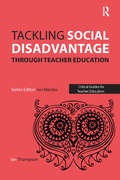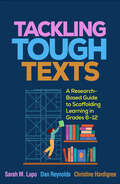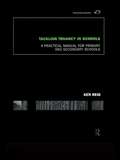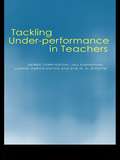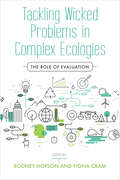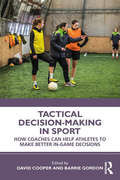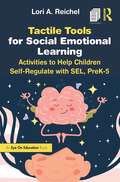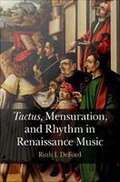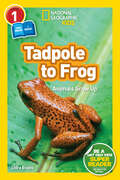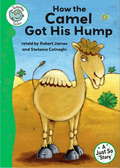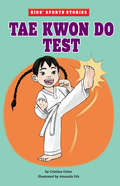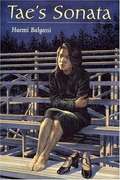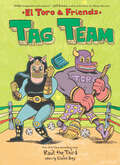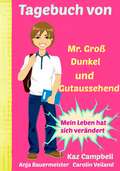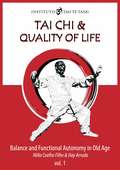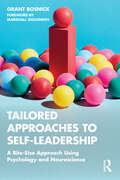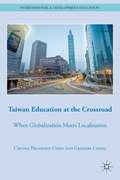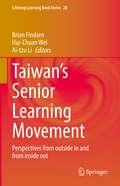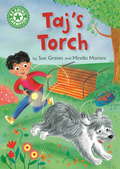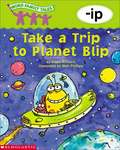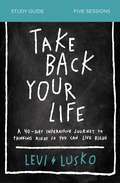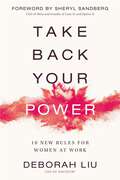- Table View
- List View
Tackling Social Disadvantage through Teacher Education (Critical Guides for Teacher Educators)
by Ian ThompsonThis book addresses key issues related to teaching pupils from disadvantaged and impoverished backgrounds and provides a valuable reference and pedagogical tool for teachers and teacher educators. Research has consistently shown that the most economically disadvantaged pupils have the poorest educational outcomes. Austerity government policies and pressures of performativity on schools may have exacerbated this inequality. Yet many teachers remain ill-informed about the effects of social disadvantage on students’ learning and consequently are ill-prepared in appropriate teaching methods. The text critically examines the lessons from previous policy and practice, discusses cognitive and affective aspects of school learning for disadvantaged children and explores the pedagogic implications of research evidence. Using insights from existing research, the book examines the reasons why some trainees and teachers lack a critical perspective on the contexts of poverty and may hold deficit views of students in poverty that suggests they are unable to learn and need to be controlled. It explains some of the links between poverty, special needs, literacy and educational achievement and focuses on strategies for improvement.
Tackling Tough Texts: A Research-Based Guide to Scaffolding Learning in Grades 6–12
by Sarah M. Lupo Christine Hardigree Dan ReynoldsFilling a crucial need, this book provides concrete ways to support all students in grades 6–12 as they engage with rigorous grade-level texts in English language arts, science, and social studies. The authors offer fresh insights into adolescent reading and what makes a given text "tough"--including knowledge demands, text structure and complexity, vocabulary, and more. Research-based, step-by-step strategies are presented for explicitly scaffolding these challenges in the context of purposeful learning activities that leverage students' individual strengths and interests. The book includes planning tips, text selection guidelines, sample text sets, and vivid case studies from culturally and linguistically diverse classrooms. Fourteen reproducible forms and handouts can be photocopied or downloaded for use with students.
Tackling Truancy in Schools: A Practical Manual for Primary and Secondary Schools
by Ken ReidFirst Published in 2004. Routledge is an imprint of Taylor & Francis, an informa company.
Tackling Under-performance in Teachers
by Derek Torrington Jill Earnshaw Lorrie Marchington Eve RitchieAll headteachers will be faced with a member of staff who is under performing at some stage in their career, but knowing how to deal with the problem to everyone's benefit is not always easy. Through the use of case studies the expert authors examine ways under-performance can be handled in a range of circumstances. Clear guidance is given on procedures that should be followed to ensure actions are within a legal framework and within current directives on performance management. Key sections include:* how to handle capability issues* ill health and capability* procedures and the legal framework* performance management. Tackling Under-performance in Teachers will be a valuable resource for headteachers, school governors and LEA officers involved in school management.
Tackling Wicked Problems in Complex Ecologies: The Role of Evaluation
by Rodney Hopson and Fiona CramTackling Wicked Problems in Complex Ecologies is a call to action, focusing on the role that evaluators can play in addressing social and economic problems. Evaluation extends beyond theories and methods, encompassing a range of proven approaches for addressing ecological complexities that drive inequities around the globe. Bringing together leading thinkers and problem-solvers, this collection traverses the range of contexts at the frontiers of the field—from inadequate food supply and housing to unemployment and poverty. Editors Rodney Hopson and Fiona Cram demonstrate the effects of an engaged approach to evaluation, in which three considerations take center stage: its relevance, the relationships it engenders, and the responsibilities it requires. This is a handbook for tackling the social and economic problems of the twenty-first century which, though wicked, are amenable to the tools of the trade.
Tackling the Motivation Crisis: How to Activate Student Learning Without Behavior Charts, Pizza Parties, or Other Hard-to-Quit Incentive Systems
by Mike AndersonTeachers use traditional incentive and reward systems with the best of intentions. We're trying to support students' positive behavior and learning. We're hoping to motivate and inspire students to work hard and do well in school. If everyone behaves, we'll have a pizza party. The more books you read, the more stickers you'll receive. On the surface, these systems seem to make sense. They may even seem to work. But in the long term, they do not foster intrinsic motivation or a love of learning. In fact, they often have the opposite effect.
Tactical Decision-Making in Sport: How Coaches Can Help Athletes to Make Better In-Game Decisions
by David Cooper Barrie GordonThis book expands on the ‘Developing Thinking Players’ model across a wide range of team and individual sports, to explain how coaches can help athletes to learn how to make better decisions during play and to think for themselves. It provides an overview of game-centred and athlete-centred approaches to teaching and coaching in sport, combining essential theory with practical tips and guidance. Written by an international team of coaching researchers and practising coaches, the book provides sport-specific instructions for coaching players in territory games, net games, striking games, target games, racquet games and combat sports, including netball, basketball, ice hockey, cricket, softball, football, rugby, volleyball, squash and karate. The book argues that the implementation of these student and athlete-centred approaches creates more opportunities for athletes to understand their sport and improves their ability to think for themselves and to learn to make better in-game decisions. Providing a theoretical underpinning for teaching tactical decision-making, it considers the development of players at all levels and age groups, from youth athletes to elite level. Thirteen sport-specific case studies offer real-world coaching insights. This is essential reading for any student, researcher or practising teacher or coach working in sport, physical education and coach education.
Tactile Tools for Social Emotional Learning: Activities to Help Children Self-Regulate with SEL, PreK-5
by Lori ReichelMany emotional learning activities – the “E” in Social Emotional Learning (SEL) – include self-regulation skills typically led by teachers, but why not empower young people by giving them tools to choose their own self-regulation techniques? This practical and comprehensive book features 52 activities focusing on emotional learning, specifically self-regulation skills that incorporate tactile objects students can store in their personal “toolboxes.” Each activity can be taught or guided by a teacher or classroom leader, supporting children to take charge of their own feelings and behavior, and thereby their own learning success. Tactile Tools for Social Emotional Learning is an important addition to any teacher’s toolkit and is key reading for early childhood educators, elementary school teachers, resource/SPED teachers, and pre-service teachers.
Tactus, Mensuration, and Rhythm in Renaissance Music
by Ruth I. DefordRuth DeFord's book explores how tactus, mensuration, and rhythm were employed to articulate form and shape in the period from c. 1420 to c. 1600. Divided into two parts, the book examines the theory and practice of rhythm in relation to each other to offer new interpretations of the writings of Renaissance music theorists. In the first part, DeFord presents the theoretical evidence, introduces the manuscript sources and explains the contradictions and ambiguities in tactus theory. The second part uses theory to analyse some of the best known repertories of Renaissance music, including works by Du Fay, Ockeghem, Busnoys, Josquin, Isaac, Palestrina, and Rore, and to shed light on composers' formal and expressive uses of rhythm. DeFord's conclusions have important implications for our understanding of rhythm and for the analysis, editing, and performance of music during the Renaissance period.
Tadpole to Frog (Readers)
by Shira EvansCaterpillar to butterfly, tadpole to frog--some creatures take growing up to a whole new level!Learn all about how animals grow and change in this leveled Co-reader, perfect for parents and kids to read together. Through vibrant, adorable images and expert-vetted text, you'll glimpse some of the most amazing metamorphoses in the natural world. Kids will see a tadpole transform into a frog, watch a caterpillar become a butterfly, and learn how a nymph becomes a dragonfly. National Geographic Kids Readers have been a hit in the beginning reader category, and this book builds upon that success with a new approach--parents and children reading together. With the same combination of careful text, brilliant photographs, and fun approach to high-interest subjects that has proved to be a winning formula with kids, National Geographic Co-readers provide one page of adult read-aloud and one page of kid read-aloud text on each spread, building toward a collaborative reading experience.
Tadpoles Tales: Just So Stories - How the Camel Got His Hump (Tadpoles Tales)
by Robert JamesIs the Camel the laziest creature on earth? The other Animals want to get him out of the Howling Desert to do his fair share of work. Can the Jinn help?
Tae Kwon Do Test (Kids' Sports Stories)
by Cristina OxtraMina has all the skills it takes to pass her upcoming yellow belt test in Tae Kwon Do with flying colors. However, a fellow student's struggle shakes her confidence and tempts her to quit.
Tae's Sonata
by Haemi BalgassiTae, a Korean American eighth grader, tries to sort out her feelings when she is assigned a popular cute boy as a partner for a school report and later has a falling out with her best friend.
Tag Team: El Toro & Friends (World of ¡Vamos!)
by Raúl the Third III"Wildly imaginative and creative! Your kids will go loco for El Toro!" —Jeff Kinney, #1 New York Times bestselling author of the Diary of a Wimpy Kid seriesFrom New York Times bestselling, three-time Pura Belpré Award–winning author-illustrator Raúl the Third, Tag Team features El Toro and La Oink Oink's team-up in Spanish and English in this graphic-novel-style El Toro & Friends paper-over-board reader from the Eisner-nominated World of ¡Vamos!Little Lobo introduced readers to his wrestling hero El Toro in Vamos! Let’s Go to the Market! Now El Toro is off on his own adventures in this early reader graphic novel series!After last night’s match, the stadium is a mess! There is so much work to be done and Mexican wrestling star El Toro feels overwhelmed.Enter . . . La Oink Oink! With the collaborative spirit they have in the ring, El Toro and La Oink Oink tackle the cleaning up together. La Oink Oink sweeps and El Toro picks up the trash. La Oink Oink washes the dishes, and El Toro dries them. Together, an insurmountable mountain of chores becomes a series of fun tasks for these two wrestling friends!With unique, detailed illustrations and easy Spanish and English vocabulary words, sports fans and comic book fans alike will fall in love with El Toro, La Oink Oink, and their tag-team adventures in this fun early reader graphic novel.
Tagalog in a Flash Volume 1
by Edwin LimTagalog in a Flash: Volume I is an excellent new language learning resource for beginning students of Tagalog.Tagalog is the national language of the Philippines, and the beloved language of the second-largest Asian-American ethnic group.<P><P>With a full range of features to help beginners and intermediate learners, Tagalog in a Flash Volume 1 is an excellent learning tool for anyone who wants to master Tagalog (also known as Filipino). Containing 448 flash cards of the most commonly used Tagalog words and phrases, along with sample sentences, handy indexes and a guide to using the cards for most effective learning, Tagalog in a Flash Volume 1 delivers.Contains 448 flash cars plus a 16 page index booklet.Learn 448 main words plus 1,792 related words, phrases and expressions.Pronunciation and accent marks given for all 448 main words.Arranged and sequenced in thematic groups and usage frequency.
Tagebuch von Mr. Groß, Dunkel und Gutaussehend
by Anja Bauermeister Kaz CampbellMr. Groß, Dunkel und Gutaussehend (kurz, Mr. GDG) … das ist Maddi Bulls (ja, die Maddi aus dem Tagebuch eines beinahe coolen Mädchens) Spitzname für Richard Jones. Verfolge seine Tagebucheinträge, um herauszufinden, was er von Maddi hält und was sonst noch in seinem Leben vor sich geht. Manchmal kann das Leben sehr schwer sein, besonders, wenn man erst vor kurzem seine Mom in einem Autounfall verloren hat. Aber Maddi zaubert immer wieder ein Lächeln auf das Gesicht von Mr. GDG. Eines Tages entdeckt Richard die Taschenuhr seiner Mom, ein altes Familienerbstück, das von Generation zu Generation weitergereicht wurde. Schon seine Oma erzählte ihm Geschichten über ihre unglaublichen Abenteuer damit. Könnte es sein, dass ihre Geschichten tatsächlich wahr sind? Hat die Taschenuhr etwas mit diesen Erlebnissen zu tun? Wird Richard der Sache auf den Grund gehen oder folgt er dem Rat seines Dads und lässt die Finger davon? Ein super Buch für junge Mädchen im Alter von 8 bis 12 Jahren. Das hier sagen unsere wunderbaren Leser: Ich liebe es! Es ist so toll, inspirierend für alle beinahe coolen Mädchen. Das Buch zeigt, dass Mr. Groß, Dunkel und Gutaussehend eine weiche Seite hat! Es ist so süß! Ich finde das Buch wirklich gut; ich glaube, es ist eines meiner Lieblingsbücher. Am Anfang war es sehr traurig. Weißt du, meine beste Freundin hat ihre Mutter verloren und sie hat das Buch auch gelesen und gesagt, dass es ihr genauso ging. Mir gefällt auch, dass Maddi ihr eigenes Tagebuch schreibt, aber dann kann man auch das von Mr. GDG lesen. Ich liebe dieses Buch, ach bitte, bitte, bitte schreibe noch eins für mich! Ich liiiiiiiiiiebe dieses Buch kannst du noch eins schreiben bitte weil es mir so gut gefallen hat (wirklich) bitte!!! Von der Autorin: Im Tagebuch von Mr. Groß, Dunkel und Gutaussehend geht es um Richard…ja, genau, Maddis Freund (aus dem Tagebuch eines beinahe coolen Mädchens). Du kannst hier mehr übe
Tai Chi - Balance and Functional Autonomy in Old Age
by Hélio Coelho Filho Hay Arruda Nuno Filipe Oliveira E Sá Da Costa LopesEste Livro Contém Evidências Científicas Que suportam OS Benefícios de Saúde de Tai Chi, espiritual SEJA, físico UO mental. Descubra OS Fatos POR Trás o que Faz this arte milenar AINDA Estar alto Nos Tempos Modernos. DEIXE-se guiar POR Especialistas NAS artes alquímicas do Movimento, um passeio parágrafo Os Jovens e Velhos almas, Uma Ótima Leitura Para Novatos e Especialistas Nos Caminhos dos Sábios. Inclui Uma Lista detalhada de Formas e Sabedoria Taijiquan de Vários Praticantes Além dos Autores, comeu MESMO o lendário Zhang San Feng e Lao Zi! 祝 您 长命 百岁! (Revista Você PODE viver 100 anos!)
Tailored Approaches to Self-Leadership: A Bite-Size Approach Using Psychology and Neuroscience
by Grant BosnickThis book provides a uniquely adaptable approach to develop awareness (of self, others and one’s environment) of self-leadership through real behavioral change. Through neuroscience, psychology and behavioral science approaches, each chapter will help readers make their learning and development personal and take it to a deeper level. With a tip of the hat to the gamebook format where you choose your adventure, readers are encouraged to take an original online self-assessment quiz to determine the challenges and priorities they are presently facing. The quiz then provides a suggested reading order of chapters to address these growth areas. Each of the 18 chapters explores a different theme related to self-leadership and are written in such a way that one can read them in any order. Filled with practical activities, reflective questions and personal anecdotes, Bosnick encourages readers to understand behavior from the "inside-out" of neuroscience and how the brain works, while also keeping an eye on the "outside-in:" how we understand others and how others see us. Combining research-backed principles with tried-and-tested exercises, this is a book tailored for leaders of all levels, professionals in a transitory phase of their career, as well as those just starting out in the working world.
Tailored Gamification to Educational Technologies
by Ig Ibert Bittencourt Wilk OliveiraThis book introduces and explores the field of tailored gamified educational technologies. Providing a theoretical overview of the domain, including a number of related psychological and educational theories along with a complete state-of-the-art analysis on this topic, it presents an approach and architecture to tailor these systems to students’ gamer type and age.
Taiwan Education at the Crossroad
by Chuing Prudence Chou Gregory ChingChou and Ching examine the processes of schooling in Taiwan amidst social, cultural, economic, and political conflict resulting from local and global dilemmas. Collectively, these issues offer a panoramic and in-depth glimpse from the past to the future of educational trends in Taiwan.
Taiwan’s Senior Learning Movement: Perspectives from outside in and from inside out (Lifelong Learning Book Series #28)
by Brian Findsen Hui-Chuan Wei Ai-Tzu LiThis volume provides an in-depth analysis of historical and recent developments of senior learning in Taiwan, where publications in English have been scant. It takes a broader view on lifelong learning and active ageing from a theoretical/conceptual base written by prominent international authors- this represents the ‘outside in’ perspective. The ‘inside out’ on the other hand signifies an in-depth investigation of initiatives written by authors from Taiwan who are closely involved with developments in policy and practice. The volume is situated theoretically in the intersection of complementary concepts such as lifelong learning, active ageing, later life learning, learning communities and social movements. It is located geographically and culturally in East Asia where senior learning/education is expanding in response to large populations of older adults and concerns about their physical and social well-being. It is argued that Taiwan is leading the way in terms of innovation and community engagement in regard to older adult learning/education and can thus serve as a model for neighboring countries. By analyzing historical precedents, cultural dynamics, policy trends, research sub-fields and community engagement this book is of interest to both East Asian and Western scholars, practitioners, policy-makers and students amongst the fields of lifelong learning, social gerontology and educational psychology.
Taj's Torch: Independent Reading Green 5 (Reading Champion #637)
by Sue GravesThis story is part of Reading Champion, a series carefully linked to book bands to encourage independent reading skills, developed with Dr Sue Bodman and Glen Franklin of UCL Institute of Education (IOE)When Taj gets a torch for his birthday, he keeps shining it in everyone's face - and they are not too pleased!Reading Champion offers independent reading books for children to practise and reinforce their developing reading skills.Fantastic, original stories are accompanied by engaging artwork and a reading activity. Each book has been carefully graded so that it can be matched to a child's reading ability, encouraging reading for pleasure.
Take A Trip To Planet Blip (Word Family Tales™ -ip)
by Kama Einhorn Matt PhillipsJump in our spaceship and take a trip--all the way to planet Blip! You'll giggle at the wacky way of life on this out-of-this-world planet! WORD FAMILY TALESTM are humorous read-aloud stories created to build early phonics skills by teaching children to recognize "families" of words that share the same spelling pattern. This key reading strategy helps kids decode new words with ease--and become stronger readers, writers, and spellers. Set learners on the path to literacy success with these rib-tickling tales--one for each of the top 25 word families!
Take Back Your Life Bible Study Guide: A 40-Day Interactive Journey to Thinking Right So You Can Live Right
by Levi LuskoThis forty-day interactive journey challenges you to come face to face with the real you, identify the internal battles you must declare war on, and become the difference-maker God created you to be. Every person has a mission and a God-given potential to impact the world, whether they recognize it or not. But the stuff of life—the loss of a job, the death of a friend or a loved one, the inability to focus due to bad moods or self-sabotaging tendencies—presents challenges and traps us in a helpless, hopeless loop of anxiety and fear. In the Take Back Your Life study (DVD/video streaming sold separately), Levi Lusko gives us forty daily challenges to come to terms with the reality of the battle and take up the weapons God has given us to engage in the fight. When we fail to recognize the reality of our situation, take back your life and fix your eyes on God. When the enemy is seeking to defeat and demoralize us, take back your life by responding to the Holy Spirit's power. When you have to decide whether to play it safe or cross the barbed wire, take back your life by tearing down strongholds. When you have to face your fears, take back your life by stepping out of your comfort zone and following God's call. When you find yourself in the wilderness, take back your life by embracing the struggle and making time with God a priority. This is a journey to get back the life you know you were born for. To change your thinking so you can change your living. To become the difference-maker God sees when he sees you. It&’s your choice. Sessions include: Look in the Mirror Turn Off the Dark Cross the Barbed Wire Run Toward the Roar Embrace the Struggle Designed for use with the Take Back Your Life Video Study available on DVD or streaming video, sold separately.
Take Back Your Power: 10 New Rules for Women at Work
by Deborah LiuYou can't make the world fair, but you can take back your power. As a woman in Silicon Valley who worked her way to the top of the corporate ladder--she's a former VP at Facebook and the current president and CEO of Ancestry--Deborah Liu knows firsthand the challenges and obstacles in the workplace that keep the deck stacked against women in the workplace . . . and the ways to overcome them.For every woman who grew up competing on the uneven playing field, who is told she is too aggressive, assertive, dramatic, or emotional, this book is the battle cry you need to learn to thrive within the system that exists today, even if it's not the one we wish it were.Take Back Your Power presents both hard data and Liu's personal experiences from twenty years as a woman leader in the male-dominated tech industry to help you:Find your voice, learn how to ask, and achieve what you want in a system that isn't fair and wasn't created for youDebunk the negative connotations of "power" and harness it for your own successDiscover how to be heard, seen, and taken more seriously at work by getting out of your own wayOvercome the lie that success is only achieved alone by finding the four types of allies you need to reach your goalsBecome a great leader without losing yourself in the processYou have the power to change the future of work for yourself--and for women everywhere.
